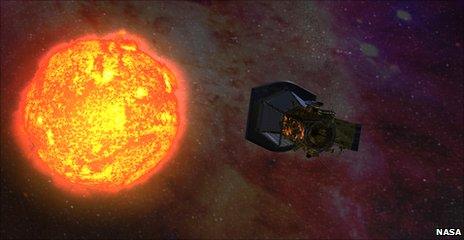Nasa hopes to send a craft into the Sun's atmosphere
- Published

An artist's impression of Solar Probe Plus heading towards the Sun
Nasa is aiming to get closer to the Sun than ever before, with plans to plunge a car-sized unmanned spacecraft into the star's outer atmosphere.
Scientists hope to launch the Solar Probe Plus (SPP) sometime before 2018.
Before it is destroyed by the sizzling temperatures exceeding 1,400C (2,550F), the craft will have to obtain valuable data about our parent star.
The solar probe project is expected to cost in the region of about $180m (拢120m).
To withstand the temperatures and the radiation, the instruments will be protected by a huge carbon-composite heat shield that still needs to be built.
Researchers say that the Sun is one of the few places people have not yet sent a spacecraft.
"Trying to understand how the Sun influences the Earth is quite a big thing these days," Richard Harrison, a solar physicist from the UK's Rutherford Appleton Laboratory, told 成人快手 News.
"The one thing we've never done is actually go there. You think of a spacecraft flying past Mars or Venus, but with the Sun, it is a little bit different.
"[But we are capable of sending] spacecraft near the Sun and that's the plan for the next generation of spacecraft."
The New Solar Telescope captured this image of a sunspot - probably the most detailed picture of a sunspot taken in visible light
Lika Guhathakurta, Solar Probe Plus programme scientist at Nasa Headquarters in Washington DC, said that "for the very first time, we'll be able to touch, taste and smell our Sun."
The spacecraft will be equipped with various instruments, among them a solar wind particle detector, a 3D camera, and a device to measure the magnetic field.
The Sun's outer atmosphere is called the corona and it is several hundreds of times hotter than the photosphere, or the visible surface of the star.
The Sun's corona is visible during a total solar eclipse
Professor Harrison said that to many people, it might seem strange that the Sun actually has an atmosphere.
But it does, he explained: "It's this million-degree plasma [that consists of] charged particles, trapped in magnetic loops, sort of super-magnetic fields."
One of the aims of the SPP mission is to understand the nature of the "solar wind", the mass of charged particles that billows away from the Sun into space.
"The experiments selected for Solar Probe Plus are specifically designed to solve two key questions of solar physics: why is the Sun's outer atmosphere so much hotter than the Sun's visible surface, and what propels the solar wind that affects Earth and our Solar System," said Dick Fisher, director of Nasa's Heliophysics Division in Washington DC.
"We've been struggling with these questions for decades and this mission should finally provide those answers."
The SPP is not the only project underway to get close to the Sun. Both Nasa and the European Space Agency (Esa) are working on another mission called Solar Orbiter, a satellite that may go to the star at the end of this decade also.
But Professor Harrison said that the SPP has far more ambitious goals.
"The Solar Probe will literally slice through a bit of the Sun's atmosphere, and that's never been done before," he said.
"The real challenge will be making the measurements - you don't want to just measure the effects that you've driven on the atmosphere [by the spacecraft].
"It's a bit like if you're pushing a boat through a river and measuring something about the surface - you don't want to measure the ripples from the boat. It's a real challenge, but it's something that is do-able."
- Published13 August 2010